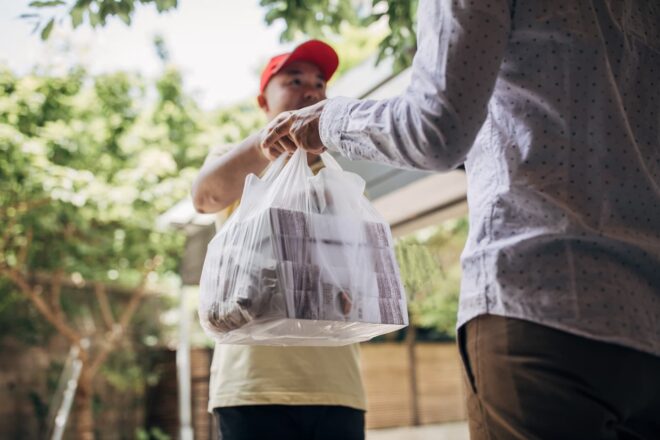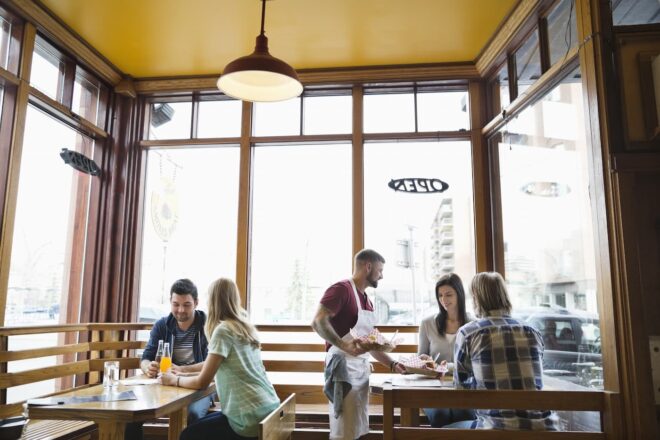How to buy a restaurant
Editorial Team
7 min read
It’s notoriously difficult to succeed in the restaurant industry–especially when opening a new eatery. It’s estimated that around 60% of new restaurants fail in their first year–80% close within five years. Instead, many entrepreneurs choose to buy an existing restaurant to overcome the many obstacles that come with opening a new restaurant.
Buying an existing restaurant can offer several advantages associated with investing in a proven concept. Yet, purchasing a restaurant can bring a new set of challenges that are worth considering before you take the plunge.
In this guide, we’ll compare buying a restaurant versus starting one from scratch, provide tips on evaluating different restaurants for purchase, and list resources that can help you get up and running.
Launch vs. buy: Should you buy a restaurant?
There are several advantages to buying a restaurant. First and foremost, an established restaurant comes with a track record–that can lower the risk of starting a restaurant from scratch. For instance, depending on how successful the restaurant has been, you’ll inherit a customer base, trained staff, and the equipment and space you need to hit the ground running. One of the most difficult aspects of starting a restaurant is building a customer base. Ideally, buying an existing restaurant means you’ll acquire its loyal clientele.
An existing restaurant also has an established cash flow, as well as a system in place for managing inventory, staffing, and running the kitchen. You likely won’t need to invest in equipment, furniture, permits, and build-out costs. Ideally, the restaurant you purchase also comes with a team of trained employees. These elements combined can save you a lot of money compared to starting a restaurant from scratch.
READ: Culinary dreams: How to open a restaurant with no money
However, these advantages often come with caveats. There’s no guarantee that employees will stick around for a change of management or if you start changing the operating model. You’re inheriting an existing culture, and as a result, there could be issues with employee morale, skill level, or even contracts that need to be addressed. You’re also taking on an existing concept, menu, and potentially a location that may need renovation. And, making drastic changes could alienate existing customers.
It can also be difficult to assess the financial and operational status of the restaurant before the purchase goes through. There could be underlying issues like aging equipment, deferred maintenance, or a poor reputation that can take time and money to address.
Finally, remember that past performance isn’t always a guarantee of future success. You’ll need to carefully analyze the financials and reasons behind any decline in sales or profitability. Why is the restaurant being sold, to begin with? Investigate why the owner is selling to avoid inheriting their problems.
With these considerations in mind, let’s dive into how to buy an existing restaurant.
How to purchase a restaurant
The process of purchasing a restaurant can vary depending on the existing establishment’s assets, years in business, and location. This overview can help give you a better sense of the commitment and time it takes to find a restaurant that fits your risk profile and vision.
1. Franchise or independent restaurant?
The first question you need to ask is whether you want to buy an independent restaurant or sign up to franchise a new location from an existing brand. There are pros and cons to each option. If you’re unfamiliar with the franchise model, check out our guide: How to franchise a restaurant. Franchising is a way to lower your risk when getting into the restaurant industry, but you may not have the flexibility you want for making the restaurant fit your unique vision.
2. Start exploring what restaurants are for sale
There are a few effective options for finding restaurants available for purchase. One option is to work with a broker. A business broker or commercial real estate broker can connect you with opportunities in your area. In metropolitan markets, you may even be able to find a specific restaurant broker who can help in your search.
Alternatively, several online resources can help your search. Try sites like Restaurants For Sale Online, We Sell Restaurants, and BizBuySell to see what might be available in your area.
3. Do your research
As you evaluate potential opportunities, you want to ask the right questions. GrubHub offers this list of questions you can ask to assess whether a restaurant for sale is the right fit for you, including:
- Is the kitchen equipment included in the sale?
- What does the restaurant’s supply chain look like?
- Is the real estate owned or leased?
- Are there any problems that must be addressed before opening?
You should also ask to see the eatery’s key metrics, including profit margin, cash flow, food costs, and labor costs.
READ: Understanding restaurant profit margins and their importance
4. Make an offer
The process varies, but usually at this point, a third party will step in to help you and the restaurant seller agree to the terms of the sale. In some cases, you will need to hire a lawyer to help you prepare a letter of intent, purchase agreement, and lease agreement if you are taking over an existing commercial lease. You may also need an appraiser to determine the fair sales price.
Fit Small Business offers this tip: “A standard guideline for determining a ballpark restaurant value is to calculate three times the annual profit.”
If a broker has been involved up to this point, that person can help you get the standard documents together to make an offer. This person may also be able to help you negotiate for a lower price if the seller seems open to the idea.
5. Secure financing
Finally, it’s time to come up with financing. The cost to start a new restaurant generally lands around $175,500 to $750,500—or $200-$500 per square foot. Of course, buying a restaurant should be less expensive, but it’s still a significant investment.
“As a general rule, restaurant owners and investors often aim to sell a restaurant for 25% to 40% of its yearly sales or gross income. For example, if a restaurant has sales of $1 million a year the owner might set a price of $250,000 to $400,000,” writes Marc Prosser on Investopedia.
Loans, investments from friends, family, and business investors can all help you raise the cash needed to finance your restaurant. So can Clover Capital, an advance of funds based on your future sales. Clover Capital is a great option for existing businesses that already have a sales track record.
Buying an existing restaurant checklist
Buying a restaurant is a big commitment—so make sure you have everything in place before you get cooking. Here are some things to prepare as you start your search:
- Define your vision and budget
- Identify the lawyer, broker, and appraiser you can work with
- Review the restaurant’s financials (3+ years)
- Understand why the restaurant is up for sale
- Analyze the lease agreement
- Evaluate the menu and concept
- Check the equipment’s condition
- Review staffing and permits
- Review the supplier contracts and POS system
- Check the restaurant’s marketing and social media presence
- View past health inspection reports
- Talk to customers
- Get appraisals (if needed)
- Identify financing
For more advice on getting started in the restaurant industry or on selecting a POS for restaurants, reach out to a Clover Business Consultant.
This information is provided for informational purposes only and should not be construed as legal, financial, or tax advice. Readers should contact their attorneys, financial advisors, or tax professionals to obtain advice with respect to any particular matter.
Related Posts
Clover’s got restaurant delivery covered: 4 services to try
How three small businesses are dealing with the incredible shrinking workforce
Popular Topics
Stay in touch
Sign up and learn more about Clover.
Thank you for your subscription!
More posts about starting a small business
eBook





